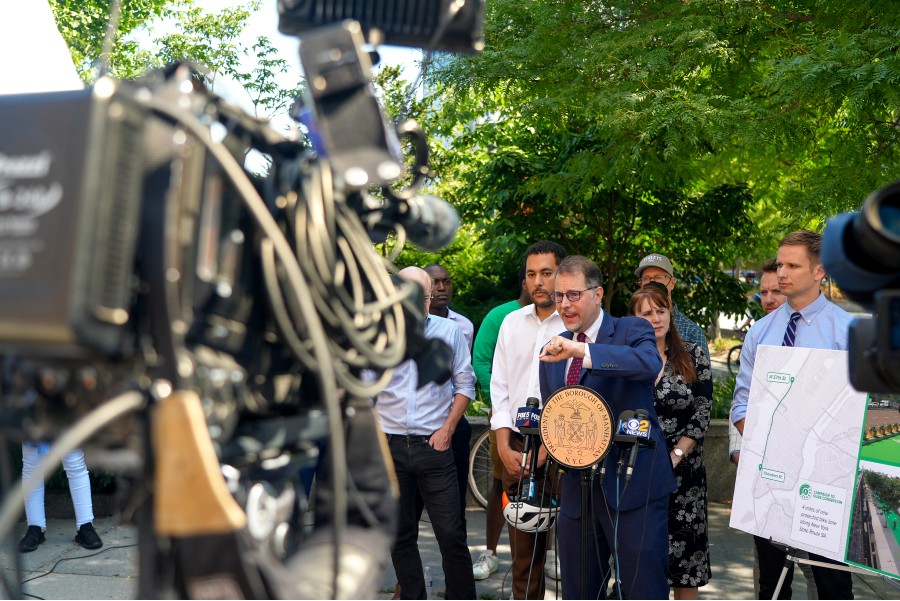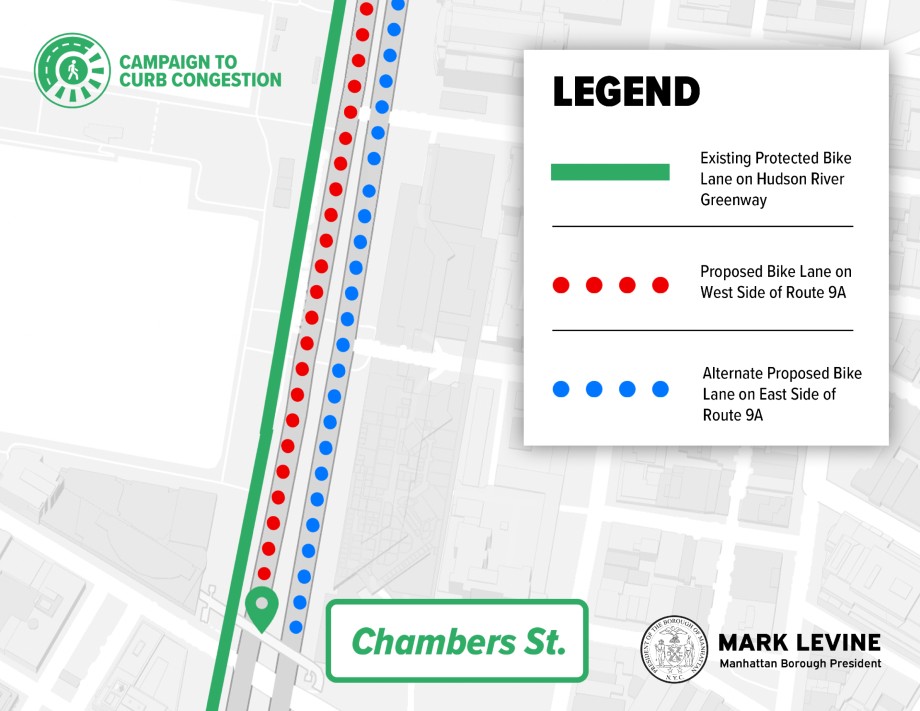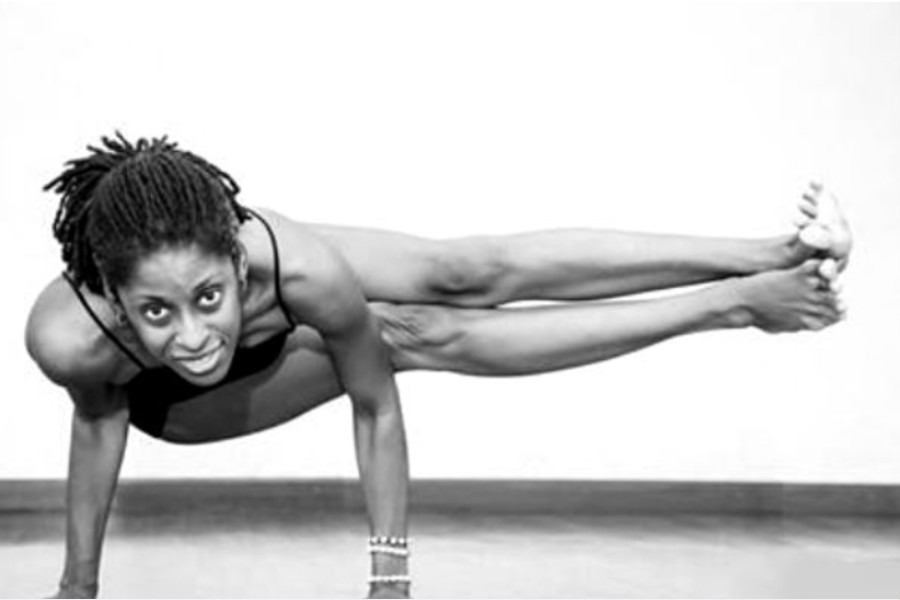
Tuesday, Manhattan Borough President Mark Levine was joined by elected officials and advocates to call on transportation officials to close one lane of vehicular traffic.
This lane is on Route 9A (West Side Highway) to create a two-way protected bike lane spanning the western shore of Manhattan.
The announcement comes as the current bike lane on the Hudson River Greenway, which runs along the West Side Highway, has become one of the most heavily used bike paths in the country.
“The Hudson River Greenway is one of the most heavily used greenways in the country, but it is overcrowded – bicyclists have to weave around people, pedestrians have to steel themselves for two-way bike traffic, and e-bikes are forced into the highway. It doesn’t have to be this way, and we could do much better,” said Manhattan Borough President Mark Levine. “Taking a lane of traffic on the highway and turning that into a dedicated, protected space for cyclists and e-bike users, including delivery workers, so that they all have a safer space to get around the city must be a key component of the city’s work to reduce congestion, reduce emissions, and create safer streets for all New Yorkers.”
Recently, congestion on the Greenway has worsened significantly, particularly as cycling has grown in popularity since the beginning of the Covid-19 pandemic and the additional increase in electric bicycle and micromobility use.
The creation of a new bicycle lane would ease congestion on the current path by creating additional space, thereby helping to alleviate potential conflicts between pedestrians and cyclists, while creating a legal space for cyclists using electric bicycles and other micromobility devices.
This proposal complements the implementation of New York City’s long-term resiliency goals and the eventual launch of Congestion Pricing by making infrastructure investments that will facilitate easy, convenient, and efficient travel without the use of a private car when these larger plans are implemented.
“We are timing this with the implementation of Congestion Pricing and the need to begin to create the infrastructure that can support and encourage the increased use of non-vehicular modes of travel by New Yorkers,” said Borough President Levine. “We expect the decrease in traffic to Manhattan to make this project feasible, and it would be a huge win for everyone traveling on foot and bikes.”
Borough President Levine has requested the State and City departments of transportation to begin studying the feasibility of the new bike infrastructure in a two-phased approach. The first phase would be implemented immediately and run between 57th Street and Chambers Street, with plans for the section of the Greenway north of 57th Street to begin shortly thereafter.
Borough President Levine was joined by a broad range of supporters to announce the plan:
“We’re living through the hottest summer on record, and it’s only going to get worse. But the West Side Highway is an example of how our City can meet this moment, and really commit to a greener way of life. We no longer have to understand highways as tools for cars alone. The West Side Highway can become the first bike highway in our city. New Yorkers are showing us that they want a greener and more efficient ways to move across the City, but if we aren’t meeting those demands we will never reduce our carbon emissions,” said Council Member Chris Marte.

“We must do everything we can to promote and encourage cycling as a healthy, efficient, and environmentally friendly mode of transportation. This includes increasing the amount of space and infrastructure dedicated to keeping cyclists safe. This proposal will also improve conditions along the Hudson River Park for pedestrians and I’m grateful that Borough President Levine is amplifying it,” said Council Member Erik Bottcher.
“Investing in protected bike lanes by repurposing space that was previously designed only for the convenience of people in motor vehicles will encourage more New Yorkers to bike, and to do it safely, while also giving e-bike riders, especially delivery cyclists, a vital west side connection,” said Anna Melendez, Manhattan Organizer for Transportation Alternatives. “We look forward to working with Borough President Levine and other elected officials to make this a reality.”
“The Hudson River Greenway is the most congested multi-use path in the U.S. It’s both an incredibly popular recreational amenity and a critical route for commuter cyclists and delivery workers, and that popularity often overwhelms the path’s existing capacity,” said Eric McClure, Executive Director of StreetsPAC. “We applaud Borough President Levine’s call to repurpose a lane of West Street for use by cyclists, e-bikers and scooter riders, which will improve safety by reducing crowding on the existing path while providing protection from heavier vehicular traffic for these cleaner, greener modes of transportation. We urge the Mayor and the Governor to get on board with BP Levine’s plan.”
“More and more New Yorkers are realizing the freedom that comes with pedaling on two wheels to get to work or the park, and our infrastructure should support that decision,” said Jeffrey LeFrancois, Chair of Manhattan Community Board 4. “As we eagerly await the implementation of Congestion Pricing, the City and State should swiftly remove one vehicular lane along Route 9A to create an additional protected bike lane for folks choosing the greener way to get from A-to-B. Manhattan Community Board 4 is grateful for Borough President Levine’s leadership on this issue, which will reduce vehicular traffic, improve air quality and cyclist safety, and provide safer access to Hudson River Park for all, too.”
“CB2 has long recognized and supported the need for a dedicated protected bike lane on West Street to accommodate the ever-growing population who use bicycles, e-bikes and e-scooters,” said Jeannine Kiely, Chair, Manhattan Community Board 2. “An additional protected bike lane will alleviate the ever-increasing overflow of bicycle activity on the Hudson River Greenway, where motor vehicles, e-bikes and e-scooters never were permitted.”
“It’s important that greenways are designed to work for users of all ages and abilities, in practice and not just in name,” said Remy Schwartz, Deputy Director, Brooklyn Greenway Initiative. “We need NYC’s greenways to keep up in the post- #BikeBoom world, and not just meet the needs of ten years ago. Expanding the available space on the Hudson River Greenway and elsewhere will ensure greenways meet the needs of people on slow walks and quick-paced rides, and everyone else in between.”
“We welcome the creation of additional space for cyclists, especially when that second bike lane is extended into Northern Manhattan as part of phase two of Borough President Levine’s plan,” said Lonnie Portis, Environmental Policy and Advocacy Coordinator at WE ACT for Environmental Justice. “Cycling can be a safe, healthy alternative to driving, which will help reduce emissions in our communities and ease the transition to congestion pricing.”
Photo credit: 1-3) M. Levine.
Become a Harlem Insider!
By submitting this form, you are consenting to receive marketing emails from: . You can revoke your consent to receive emails at any time by using the SafeUnsubscribe® link, found at the bottom of every email. Emails are serviced by Constant Contact








